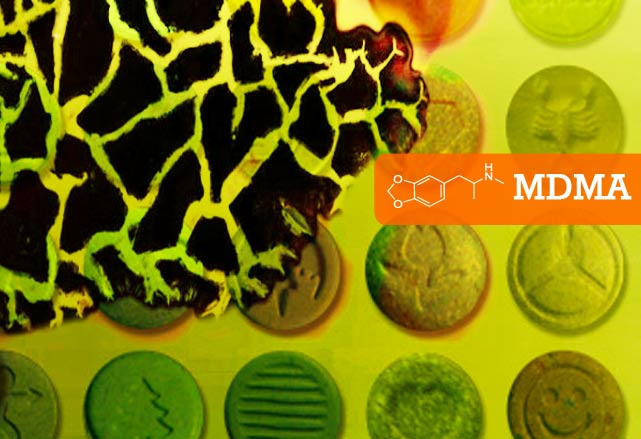 MDMA (3, 4-methylenedioxymethamphetamine) is a member of the phenylethylamine family of drugs which include 2CB, 2C-i and 2C-e.
MDMA (3, 4-methylenedioxymethamphetamine) is a member of the phenylethylamine family of drugs which include 2CB, 2C-i and 2C-e.
MDMA was first synthesised in Germany in 1912 by Merck pharmaceutical company. It was rediscovered in the 1960s and remained legal in the US until 1985. In some ways MDMA set the precedent for other novel psychoactive substances that were to follow many years later.
In the 1960s, Alexandra Shulgin synthesised around 179 substances that contained the phenethylamine structure. One of these compounds was MDMA.

Forms
– tablets, capsules, powder and crystals.
Routes of administration
– oral (crushed / snorted), smoked, some IV use.

MDMA has a variety of street names, the most famous is ‘ecstasy’. In pill form it is normally named by the stamp it has on the tablet.
Popular names have included Doves, Mitsubishis and Apples. Sometimes they are referred to by colour. MDMA crystals can be brown or pink in colour.
Since ecstasy is synthesised in laboratories, its purity can vary substantially from lab to lab, and other compounds are easily combined into the same tablet.
The nerve pathway that is predominantly affected by MDMA is called the serotonin pathway. Serotonin is a neurotransmitter that is synthesised, stored, and released by specific neurons in this pathway. It is involved in the regulation of several processes within the brain, including mood, emotions, aggression, sleep, appetite, anxiety, memory, and perceptions.
Some studies have suggested that ecstasy has no long-term impact on the levels of the neurotransmitter serotonin in the brain, while others have suggested that it leaves clubbers feeling depressed and unable to concentrate. Studies on animals show damage to neurons but how it exactly does this is not fully explained.
Subscribe to our free weekly newsletter on Linkedin
